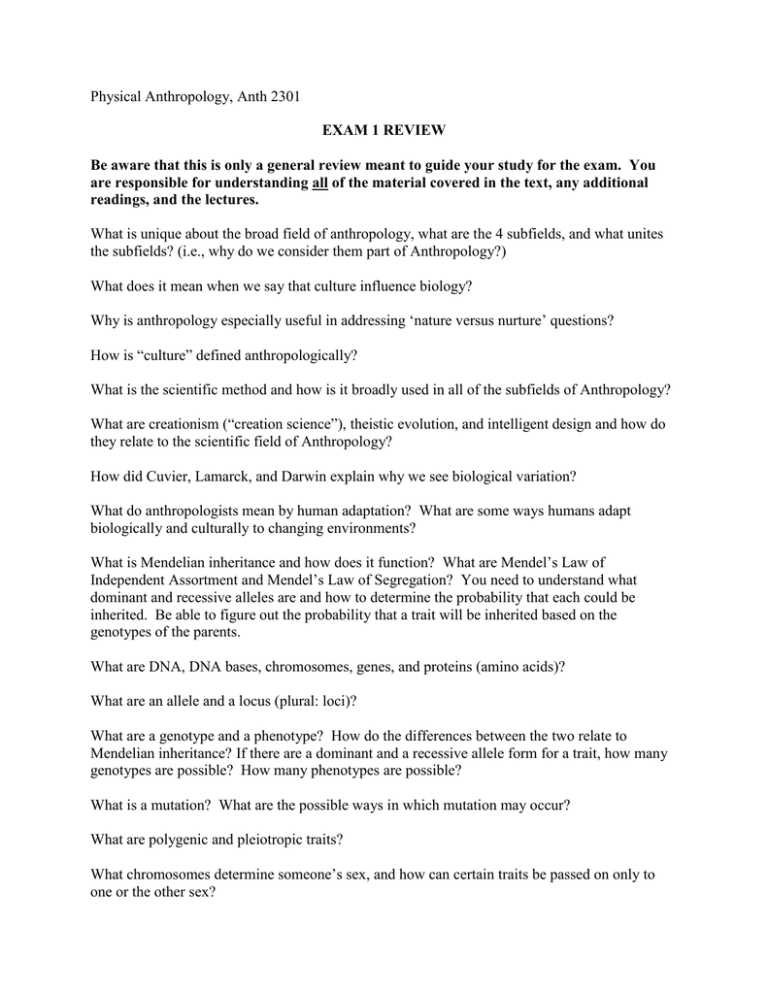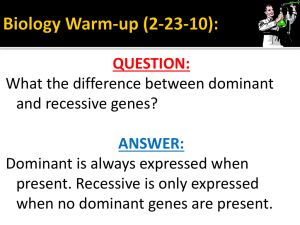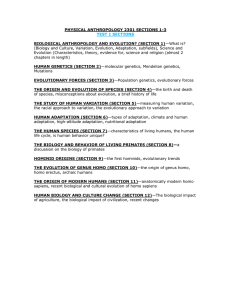PhysExam1Rev.doc
advertisement

Physical Anthropology, Anth 2301 EXAM 1 REVIEW Be aware that this is only a general review meant to guide your study for the exam. You are responsible for understanding all of the material covered in the text, any additional readings, and the lectures. What is unique about the broad field of anthropology, what are the 4 subfields, and what unites the subfields? (i.e., why do we consider them part of Anthropology?) What does it mean when we say that culture influence biology? Why is anthropology especially useful in addressing ‘nature versus nurture’ questions? How is “culture” defined anthropologically? What is the scientific method and how is it broadly used in all of the subfields of Anthropology? What are creationism (“creation science”), theistic evolution, and intelligent design and how do they relate to the scientific field of Anthropology? How did Cuvier, Lamarck, and Darwin explain why we see biological variation? What do anthropologists mean by human adaptation? What are some ways humans adapt biologically and culturally to changing environments? What is Mendelian inheritance and how does it function? What are Mendel’s Law of Independent Assortment and Mendel’s Law of Segregation? You need to understand what dominant and recessive alleles are and how to determine the probability that each could be inherited. Be able to figure out the probability that a trait will be inherited based on the genotypes of the parents. What are DNA, DNA bases, chromosomes, genes, and proteins (amino acids)? What are an allele and a locus (plural: loci)? What are a genotype and a phenotype? How do the differences between the two relate to Mendelian inheritance? If there are a dominant and a recessive allele form for a trait, how many genotypes are possible? How many phenotypes are possible? What is a mutation? What are the possible ways in which mutation may occur? What are polygenic and pleiotropic traits? What chromosomes determine someone’s sex, and how can certain traits be passed on only to one or the other sex? Generally speaking, how can environment and genetics affect human behavior? What are meiosis and mitosis? Which process relates directly to natural selection, and thus to evolution? Generally speaking, what are breeding populations, and in what biological and cultural ways may human populations be defined? How many alleles are typically found at a given locus? When given a sample population’s size and whether the given alleles are dominant or recessive, you need to be able to figure out genotype and allele frequencies in that population. What is the Hardy-Weinberg equilibrium? What does it mean in terms of evolution if its requirements are met or not met? What is natural selection? How does it function? What does it mean that something has been selected for or against? How is the British peppered moth a classic example of it? What is “fitness” in terms of natural selection? How do the following processes of natural selection operate on simple traits? What happens to the allele frequencies of dominant and recessive alleles in each case? What is an example of each? Selection against the recessive homozygote Selection against the dominant homozygote Selection for the heterozygote (balancing selection) How do the following processes of natural section operate on complex traits? Stabilizing selection? Directional selection? What is the process of genetic drift, and what are some examples of it? How does it relate to population size? What is the process of gene flow, what are some examples of it, and what are possible barriers to it? What has to happen to gene flow in order for speciation to occur? How can natural selection, genetic drift, and gene flow increase or decrease variation between and within populations? What are ways in which new genetic variations can be come into a population? What are the two main forms of nonrandom mating? What broadly defines a “species”? What role does reproductive isolation play in speciation? What is adaptive radiation? Examples? What are punctuated equilibrium and gradualism, and what are the differences? Which rate of evolution is typically demonstrated by data? What are cladogenesis and anagenesis? You need to have a clear idea of what these are and how they are different. What are the most common types of misconceptions about speciation? What examples are given in the text of each?







